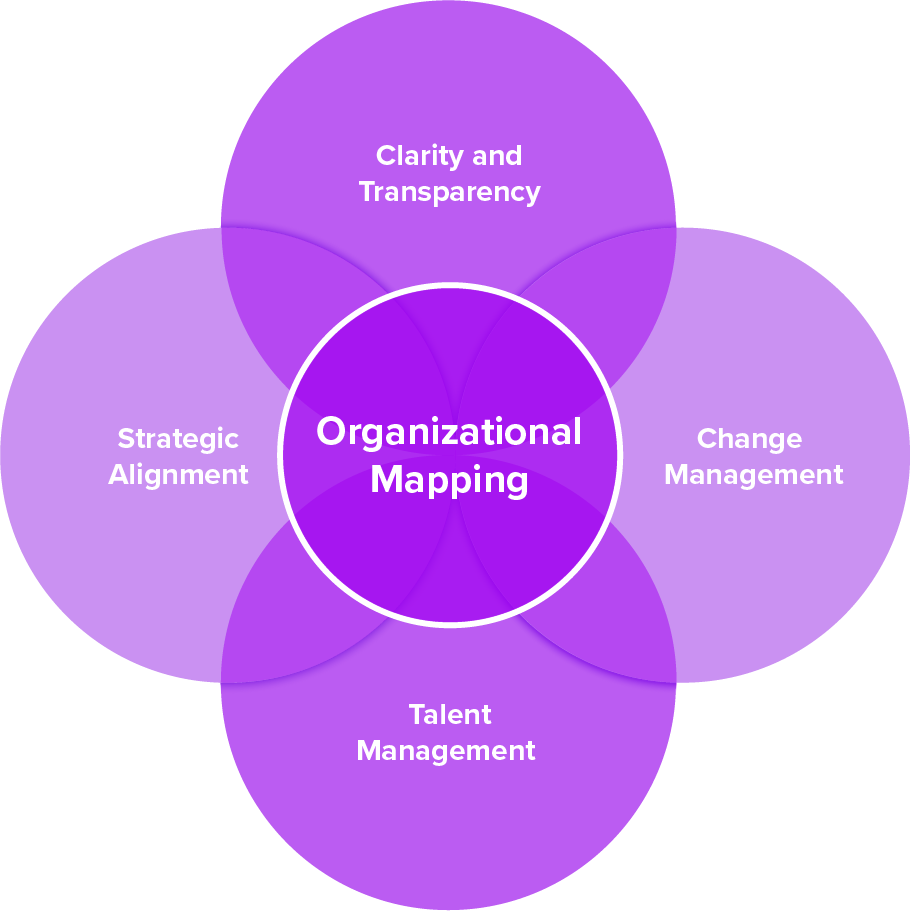In the dynamic landscape of modern business, understanding the intricacies of an organization is crucial for effective management and strategic decision-making. Organizational mapping, a powerful tool in the realm of organizational development, offers a visual representation of an organization's structure, relationships, and processes. This article aims to unravel the concept of organizational mapping and explore its various types, shedding light on how it can be a valuable asset for businesses.
Jump to:
- Understanding Organizational Mapping
- The Significance of Organizational Mapping in Modern Businesses
- Types of Organizational Maps
- Archimate and Organizational Mapping Tools
- Organizational Mapping in Ardoq
- Building a Digital Twin of the Organization
Understanding Organizational Mapping
What Is Organizational Mapping and Its Key Components
Organizational mapping is a process of visually representing an organization's structure, hierarchy, relationships, and processes. It provides a holistic view that helps stakeholders grasp the overall framework and dynamics of the organization. This visual representation goes beyond traditional organizational charts, offering a more nuanced understanding of how different components interact and contribute to the overall functioning of the entity.
Organizational mapping is a crucial aspect of effective management and strategic planning within any company or institution. The creation of visual representations of an organization's structure and key components helps to provide a clear understanding of its inner workings. The practice aids in decision-making, communication, and the alignment of organizational goals. Let's delve into the key components of organizational mapping.
1) Hierarchy
The visualization of hierarchy illustrates the levels of authority within the organization. This includes top-level executives, middle management, and frontline employees. The fundamental element of organizational mapping is the organizational chart, depicting the hierarchical structure. It outlines the relationships and reporting lines between various roles and positions within the organization.
Highlighting key personnel, especially members of the leadership team, provides a quick reference to those steering the organization. This includes executives, managers, and department heads.
2) Roles and Responsibilities
Mapping assists in clearly defining the roles and responsibilities of each position in the organization. Each position in the organization should have a corresponding position description outlining roles, responsibilities, and key tasks. This ensures everyone understands their function and contribution to the overall goals.
3) Departments and Teams
Organizational mapping highlights different departments and teams, displaying their functions and how they contribute to the overall objectives of the organization. This helps in understanding the division of labor and specialization.
It’s useful to identify collaborative networks and cross-functional relationships. Understanding how different departments or teams work together fosters a culture of cooperation and innovation.
4) Communication Channels
This component depicts the flow of communication within the organization, which helps identify potential bottlenecks and ensures efficient information exchange. Beyond the formal organizational chart, mapping should consider informal structures and communication networks. Identifying key influencers and informal leaders can enhance understanding of how information flows within the organization.
5) Processes and Workflows
Core business processes and workflows are a prominent component of organizational mapping and are another opportunity to identify potential bottlenecks through visualizing dependencies and resource allocation. Understanding processes is essential for optimizing efficiency and identifying areas for improvement.
6) Reporting Lines
Clearly defined reporting lines comprise the hierarchy of authority and indicate the flow of authority and decision-making within the organization. This component is vital for understanding the chain of command and the channels through which information travels.
7) Organizational Culture
Organizational mapping can incorporate symbols or indicators that represent the organizational culture. This might include values, mission statements, or other cultural elements that define the work environment.
8) Project and Team Assignments
For organizations engaged in various projects, mapping can include project teams and their assigned tasks. This helps in visualizing how project-based work aligns with the overall organizational structure.
9) Technology and Resources
Organizational mapping can extend to include the allocation of technology and other resources. This aids in resource planning and ensures that teams have the necessary tools to fulfill their roles.
The Significance of Organizational Mapping in Modern Businesses
Organizational mapping holds significant importance in modern businesses for several reasons.

Clarity and Transparency: Mapping or modeling provides a clear and transparent view of the organizational structure, reducing ambiguity and promoting understanding among employees. Visualizing relationships, hierarchies, and collaboration networks fosters transparency and improves communication within the organization.
Strategic Alignment: It also helps align organizational structure with strategic goals, ensuring that resources are allocated efficiently and the workforce is focused on achieving key objectives. Strategic alignment facilitates decision-making by providing insights into the organization's strengths, weaknesses, opportunities, and threats.
Change Management: Mapping assists in navigating organizational changes by visualizing the effects on various components. Change management can be improved by visualizing these impacts, aiding smoother transitions during periods of change.
Talent Management: Mapping supports talent management by identifying skill gaps, ensuring the right people are in the right roles, and fostering a culture of continuous improvement.
Types of Organizational Maps
Organizational Mapping can take various forms, each serving a specific purpose in understanding and managing an organization.
Hierarchical Organizational Charts
The traditional hierarchical organizational chart displays the vertical structure of an organization, showcasing reporting relationships, levels of authority, and the chain of command. This is the most common type of organizational map and is particularly useful for understanding lines of authority and communication within an organization.
Process Maps and Flowcharts
Process maps and flowcharts illustrate the sequence of activities and interactions involved in specific business processes. These maps are instrumental in identifying bottlenecks, streamlining workflows, and improving overall efficiency. Process maps and flowcharts can be used to pinpoint key activities, decision points, and interactions between different departments.
Process maps can be used to focus on the value stream, mapping the entire process of delivering a product or service to the customer. Using mapping in this way identifies value-added and non-value-added activities in the production or service delivery chain, and can help eliminate waste in the process.
Network Maps Showcasing Relationships and Dependencies

Network maps highlight the relationships and dependencies between different entities within an organization. This type of mapping is useful for visualizing networks and communication patterns. It helps identify key influencers and central figures within the organization, and is essential for understanding how individuals, teams, and departments interact and collaborate.
Hybrid Maps Combining Various Elements

Hybrid maps integrate elements from different mapping types to provide a holistic view of the organization. This approach allows for a comprehensive understanding of both the structural and process-related aspects of the business. For example, a relationships and dependencies map could be combined with a SWOT (Strengths, Weaknesses, Opportunities, Threats) analysis into a visual format to create a holistic view of the internal and external factors affecting the organization. This type of analysis would facilitate strategic planning and decision-making by highlighting areas for improvement and potential risks.
Archimate and Organizational Mapping Tools
One of the more typical organizational mapping tools for EA is Archimate, often used for implementing organizational mapping in business architecture. An open and independent modeling language developed by The Open Group, Archimate supports the description, analysis, and visualization of architecture within and across business domains.
The language is supported by a variety of software providers and consulting firms involved in supporting organizational mapping. ArchiMate assists Enterprise Architects in describing, analyzing, and visualizing the relationships among different architecture domains by providing accepted standards and instruments to follow.
The language offered by Archimate provides a simple and uniform structure for describing the contents of domains in an unambiguous way, thereby helping stakeholders to design, assess, and communicate the consequences of decisions and changes within and between these business domains. It’s frequently used to describe the construction and operation of:
- Business processes
- Organizational structures
- Information flows
- IT systems
- Technical infrastructure
The various areas in which Archimate supports domain description include:
Visual Representation: Archimate provides a standardized way to visually represent organizational structures, making it easier for stakeholders to grasp complex relationships.
Integration with Business Processes: Archimate integrates with process mapping, allowing organizations to connect their organizational structure with key business processes.
Dynamic Modeling: Archimate enables dynamic modeling, allowing organizations to adapt and evolve their structures as needed. This flexibility is essential in today's rapidly changing business environment.
Organizational Mapping in Ardoq
A Flexible Metamodel Adaptable to Any Organization’s Needs
Ardoq was intentionally created to have a flexible and customizable metamodel, allowing any organization, regardless of industry or structure, to use it as an Enterprise Architecture (EA) platform for modeling its unique circumstance or structure. If you’ve already experienced other tools available on the market, you’ll instantly recognize what a benefit this is in modern businesses.
Although many EA tools are built around standards, in practice, few practitioners are able to unlock value purely by adhering strictly to these standards. This is primarily because standards have evolved from an engineering rather than a strategy background, and modern EA practitioners need their tools to assist them in engaging with decision-makers and creating compelling narratives around business performance.
The focus for modern EA teams should be on creating value for the enterprise. Value is typically generated through insights and strategic data-driven recommendations by creating an understanding of the organization’s current and intended future state. EA insights can help create consensus and shape mandates with clear calls to action. Modern EA teams shouldn’t waste valuable resources and time struggling with inflexible tools that do not support their organization’s structure and objectives.
Once the objectives and success criteria of a modeling mission are established, Ardoq’s functionality helps practitioners get there speedily. For a more detailed deep-dive into metamodeling, read Ardoq’s Seven Principles for Creating a Great Enterprise Architecture Metamodel.
Expert-Curated Approach to Organizational Mapping
Ardoq also offers an expert-curated approach to organizational mapping that accounts for differing organizational structures or industries. This approach gives Enterprise Architects a head start in creating a model, providing the level of adaptability needed to capture the nuances of specific organizational relationships. Though there can be many organizational structures, they can broadly be broken down into three main types:
Hierarchical: Most people think of an organization in terms of the traditional hierarchical pyramid. The chart starts at the top, with authority and accountability cascading to each department-level manager and their employees.
Flat: Flattens the hierarchy and chain of command and gives its employees a lot of autonomy. Companies that use this type of structure have a high speed of implementation.
Matrix: This structure matrixes employees across different leaders, divisions, or departments. An employee working for a matrixed company, for example, may have duties in, and accountability to, both two different departments such as sales and customer service.
Pre-Built Bundles to Quickly Unlock Value
Organizational modeling adds depth and insights into an organization’s architecture beyond IT. By modeling the organization, information already in the Ardoq platform can be enriched and leveraged to develop further insights into optimize the business or guiding strategic decision-making.
A common starting point for most organizations is Application Portfolio Management, which allows for overview and insight into the applications and technology of an organization. This can then be expanded with the modelling of business capabilities, a This exercise provides crucial visibility into how the business operates and what the business does, which is a foundation for optimization. With this understanding, organizations are better able to begin pinpoint gaps and redundancies, identifying pain points, and prioritizing where to focus resources.
To make the most of this understanding and easily build on it to quickly drive business outcomes, Ardoq offers a collection of best practice guides. These guides allow for a quick start or expansion of insight into specific parts of the enterprise’s architecture such as planning for cloud migration or improving IT cost management.
For organizations with a more mature EA practice, Ardoq’s Strategy to Execution solution helps a business strategically align its objectives, change initiatives, business units, and IT. It enables clearer communication and prioritization over initiatives to fulfill the business’ overarching strategy. Ardoq helps sprawling organizations leverage data-driven visualizations around strategy and objectives to facilitate transparency, alignment, and communication across different levels of the organization.
Building a Digital Twin of the Organization
Modeling the organization and connecting it to a data-driven understanding of processes and technology could be said to be a very rudimentary beginning towards developing a “digital twin of the organization”.
Building a digital twin – a dynamic software model – of the organization means having a virtual counterpart of the entire enterprise. Detailed impact analysis can be done without any change to the actual architecture of the business, allowing for the testing of future scenarios and potential initiatives. This lowers the risk in making strategic decisions, providing decision-makers and management greater certainty. The capacity to run scenarios on a digital twin helps connect the ‘what’ to the ‘why’ of EA, essentially connecting EA back to business outcomes.
Organizations always have more innovative ideas than execution capacity, so providing decision-makers with a degree of certainty around the consequences and potential business benefits of change is vital.
Modeling the Organization: Improving Transparency and Alignment
Organizational mapping is a useful way to get a comprehensive view of an organization's structure, relationships, and processes. It helps make more visible, the complex interactions and interdependencies within organizations.
As organizations continue to evolve amid dynamic challenges, the ability to map and understand their intricacies becomes increasingly vital for sustained success. Creating a visual representation of an organization’s structure and processes can facilitate strategic planning and overall business optimization, empowering companies to navigate the complexities of the modern business landscape.
Learn more about the key trends in Enterprise Architecture that will be shaping the organizations of tomorrow.
- Blog Posts Why and How to Include People in Your Architecture New Decision-Making Structures for Cross-Organizational Collaboration
- Best Practice Guides Application Portfolio Management Business Capability Modeling
- Customer Stories Faster M&A Due Diligence Through Capabilities Mapping Enterprise Architecture Governance to Align Teams and Data
 Deborah Theseira
Deborah is a Senior Content Specialist at Ardoq. She wields words in the hope of demystifying the complex and ever-evolving world of Enterprise Architecture. She is excited about helping the curious understand the immense potential it has for driving effective change.
Deborah Theseira
Deborah is a Senior Content Specialist at Ardoq. She wields words in the hope of demystifying the complex and ever-evolving world of Enterprise Architecture. She is excited about helping the curious understand the immense potential it has for driving effective change.







